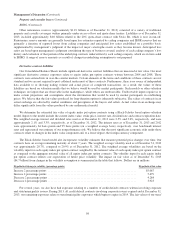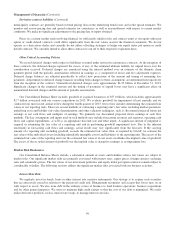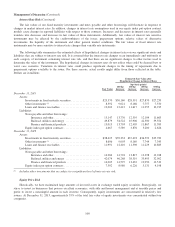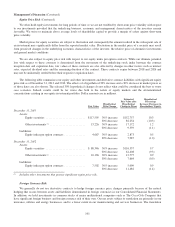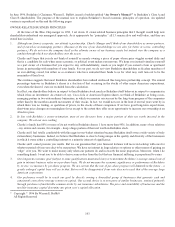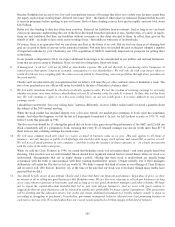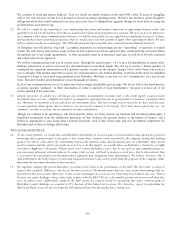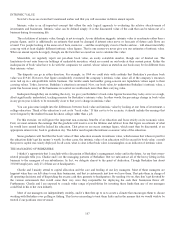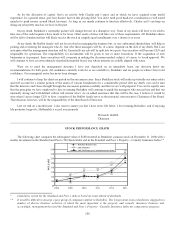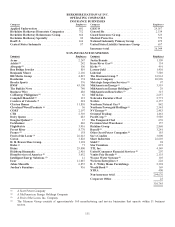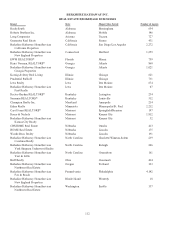Berkshire Hathaway 2013 Annual Report Download - page 104
Download and view the complete annual report
Please find page 104 of the 2013 Berkshire Hathaway annual report below. You can navigate through the pages in the report by either clicking on the pages listed below, or by using the keyword search tool below to find specific information within the annual report.
Management’s Discussion (Continued)
Foreign Currency Risk (Continued)
impact is somewhat offset by transaction gains or losses on net reinsurance liabilities of certain U.S. subsidiaries that are
denominated in foreign currencies as well as the equity index put option liabilities of U.S. subsidiaries relating to contracts that
would be settled in foreign currencies.
Commodity Price Risk
Our subsidiaries use commodities in various ways in manufacturing and providing services. As such, we are subject to
price risks related to various commodities. In most instances, we attempt to manage these risks through the pricing of our
products and services to customers. To the extent that we are unable to sustain price increases in response to commodity price
increases, our operating results will likely be adversely affected. We utilize derivative contracts to a limited degree in managing
commodity price risks, most notably at MidAmerican. MidAmerican’s exposures to commodities include variations in the price
of fuel required to generate electricity, wholesale electricity that is purchased and sold and natural gas supply for customers.
Commodity prices are subject to wide price swings as supply and demand are impacted by, among many other unpredictable
items, weather, market liquidity, generating facility availability, customer usage, storage and transmission and transportation
constraints. To mitigate a portion of the risk, MidAmerican uses derivative instruments, including forwards, futures, options,
swaps and other agreements, to effectively secure future supply or sell future production generally at fixed prices. The settled
cost of these contracts is generally recovered from customers in regulated rates. Financial results would be negatively impacted
if the costs of wholesale electricity, fuel or natural gas are higher than what is permitted to be recovered in rates. MidAmerican
also uses futures, options and swap agreements to economically hedge gas and electric commodity prices for physical delivery
to non-regulated customers. The table that follows summarizes our commodity price risk on energy derivative contracts of
MidAmerican as of December 31, 2013 and 2012 and shows the effects of a hypothetical 10% increase and a 10% decrease in
forward market prices by the expected volumes for these contracts as of each date. The selected hypothetical change does not
reflect what could be considered the best or worst case scenarios. Dollars are in millions.
Fair Value
Net Assets
(Liabilities) Hypothetical Price Change
Estimated Fair Value after
Hypothetical Change in
Price
December 31, 2013 .................................... $(140) 10% increase $ (72)
10% decrease (208)
December 31, 2012 .................................... $(235) 10% increase $(187)
10% decrease (285)
FORWARD-LOOKING STATEMENTS
Investors are cautioned that certain statements contained in this document as well as some statements in periodic press
releases and some oral statements of Berkshire officials during presentations about Berkshire or its subsidiaries are “forward-
looking” statements within the meaning of the Private Securities Litigation Reform Act of 1995 (the “Act”). Forward-looking
statements include statements which are predictive in nature, which depend upon or refer to future events or conditions, which
include words such as “expects,” “anticipates,” “intends,” “plans,” “believes,” “estimates” or similar expressions. In addition,
any statements concerning future financial performance (including future revenues, earnings or growth rates), ongoing business
strategies or prospects and possible future Berkshire actions, which may be provided by management, are also forward-looking
statements as defined by the Act. Forward-looking statements are based on current expectations and projections about future
events and are subject to risks, uncertainties and assumptions about Berkshire and its subsidiaries, economic and market factors
and the industries in which we do business, among other things. These statements are not guaranties of future performance and
we have no specific intention to update these statements.
Actual events and results may differ materially from those expressed or forecasted in forward-looking statements due to a
number of factors. The principal important risk factors that could cause our actual performance and future events and actions to
differ materially from such forward-looking statements include, but are not limited to, changes in market prices of our
investments in fixed maturity and equity securities, losses realized from derivative contracts, the occurrence of one or more
catastrophic events, such as an earthquake, hurricane or act of terrorism that causes losses insured by our insurance subsidiaries,
changes in laws or regulations affecting our insurance, railroad, utilities and energy and finance subsidiaries, changes in federal
income tax laws, and changes in general economic and market factors that affect the prices of securities or the industries in
which we do business.
102








